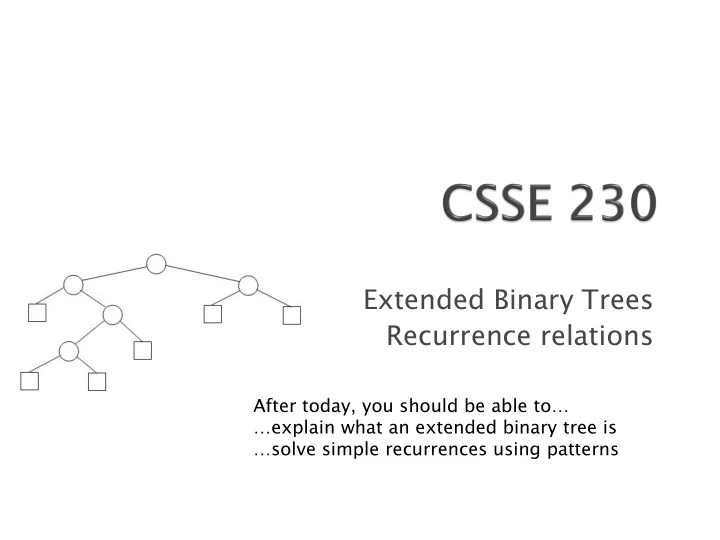

Extended Binary Trees Recurrence relations After today, you should be able to… …explain what an extended binary tree is …solve simple recurrences using patterns
Today: ◦ Extended Binary Trees (on HW10) ◦ Recurrence relations, part 1 GraphSurfing Milestone 2 ◦ Two additional methods: shortestPath(T start, T end) and stronglyConnectedComponent(T key) ◦ Tests on Living People subgraph of Wikipedia hyperlinks graph ◦ Bonus problem: find a “challenge pair” Pair with as-long-as-possible shortest path
Bringing new life to Null nodes!
1-2 Not a single NULL_NODE, but many NULL_NODEs An Extended Binary tree is either ◦ an external ( nal (nul ull) l) n node , or ◦ an ( intern rnal al ) root node and two EBTs T L and T R , that is, all nodes have 2 children Convention. ◦ Internal nodes are circles ◦ External nodes are squares This is simply an alternative way of viewing binary trees: external nodes are “places” where a search can end or an element can be inserted – for a BST, what legal values could eventually be inserted at an external node?
3-5 Propert rty P(N): For any N ≥ 0, any EBT with N internal nodes has _______ external nodes. Use example trees below to come up with a formula, let: ◦ EN(T) = external nodes ◦ IN(T) = internal nodes
3-5 Propert rty P(N): For any N ≥ 0 , any EBT with N internal nodes has _______ external nodes. Prove b by s stron ong i inducti tion on, based on the recursive definition. ◦ A notation for this problem: IN(T), EN(T) Hint (reminder): Find a way to relate the properties for larger trees to the property for smaller trees.
A technique for analyzing recursive algorithms
6 Split the sequence in half Where can the maximum subsequence appear? Three possibilities : ◦ entirely in the first half, ◦ entirely in the second half, or ◦ begins ns in the first half and end nds in the second half
Using recursion, find the maximum sum of 1. firs irst half of sequence Using recursion, find the maximum sum of 2. seco econd half of sequence Compute the max of all sums that begin in 3. the first half and end in the second half ◦ (Use a couple of loops for this) Choose the largest of these three numbers 4.
7 N = array size What’s the run-time?
8 Runtime = Recursive part + non-recursive part
9 Write a Rec ecurrence R Rel elat ation ◦ T(N) gives the run-time as a function of N ◦ Two (or more) part definition: Base case, like T(1) = c Recursive case, like T(N) = T(N/2) + 1 So, what’s the recurrence relation for the recursive MCSS algorithm?
T(n) = a T(n/ b ) + f(n) a = # of subproblems n/ b = size of subproblem f(n) = D(n) + C(n) D(n) = time to divide problem before recursion C(n) = time to combine after recursion
10 10 Runtime = Recursive part + non-recursive part
10 10 Runtime = Recursive part + non-recursive part T(N) = 2T(N/2) + θ (N) T(1) = 1
An equation (or inequality) that relates the n th element of a sequence to certain of its predecessors (recursive case) Includes an initial condition (base case) Solu olutio ion: A function of n. Similar to differential equation, but discrete instead of continuous Some solution techniques are similar to diff. eq. solution techniques
11-15 11 15 One strategy: loo ook f for or pa patt tterns ◦ Forward substitution ◦ Backward substitution Examples: As c As class ss: 1. T(0) = 0, T(N) = 2 + T(N-1) 2. T(0) = 1, T(N) = 2 T(N-1) 3. T(0) = T(1) = 1, T(N) = T(N-2) + T(N-1) On q n quiz: z: 1. T(0) = 1, T(N) = N T(N-1) 2. T(0) = 0, T(N) = T(N -1) + N 3. T(1) = 1, T(N) = 2 T(N/2) + N (just consider the cases where N=2 k )
14 14-15 15 Find patterns Telescoping Recurrence trees The master theorem
Recommend
More recommend